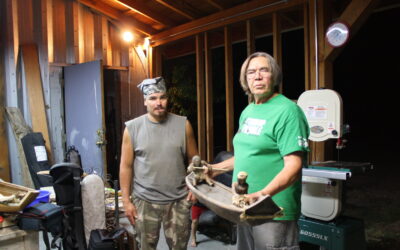Since 1974, the Imperial Valley Desert Museum has been a repository for indigenous Kumeyaay archeological collections in Imperial County and is the only cultural institution in Imperial County supporting the awareness of Kumeyaay culture and artists. The museum is in the geographic center of Kumeyaay traditional…
The Nor Rel Muk Wintu Nation’s traditional homeland lies in the headwaters of the South Fork of the Trinity River, in Trinity County, California. Approximately half of the tribe’s 1,000 members still live near their ancestral lands in Trinity and Shasta Counties. Nor Rel Muk Wintu members from across the…
The Salinans are a Native people that lived in what is now the Central Coast of California, in the Salinas Valley. The Salinan language is one of the oldest in California. Said to have gone extinct by the Census of 1930, the Salinan peoples survived and currently exist in several…
Basket weaving was once an everyday skill used by the Native peoples of Northern California. Today, basketry has become a highly specialized art form with a limited number of tribal people who possess the skill and knowledge the gather materials, process those materials, and create a living basket. Baskets are…
The far northern region of California (Humboldt and Siskoyou Counties) is the homeland of the Hupa and Karuk tribes, who have been vigilant in sustaining cultural practices related to a mode of life to which the Klamath tributary is central. Ritual and ceremony of renewal continue to be integrated in…
Wilverna Reece (Karuk) has been weaving baskets since 1978. She was taught by Karuk tribal elders Grace and Madeline Davis in Happy Camp, California. Wilverna is proficient in the skills and knowledge needed to weave many types of Karuk baskets, and has been teaching weaving to community members since 1983.
Bertha Mitchell, a master basket weaver, Patwin language speaker, and culture bearer for the Patwin people, has been weaving baskets for over seven decades. In addition to working within her own community, Bertha has shared her art with many audiences throughout Northern California, including demonstrating her art form at museums,…
The Wishtoyo Foundation is a Native American organization that utilizes traditional Chumash cultural values and practices to foster environmental awareness. The Chumash people lived for centuries along the California coast between Malibu and San Luis Obispo and the Channel Islands, depending on the natural world…
Hoopa and Yurok Traditional Arts
Shiwaya Peck, a member of the Maidu tribe of modern-day Plumas County, has been weaving baskets for nearly sixty years. She learned as a child from her grandmother, Nellie Peck, and her aunt, the renowned weaver and elder Lily Baker. As a master artist in ACTA’s…


